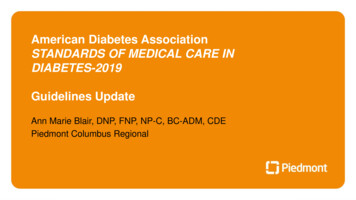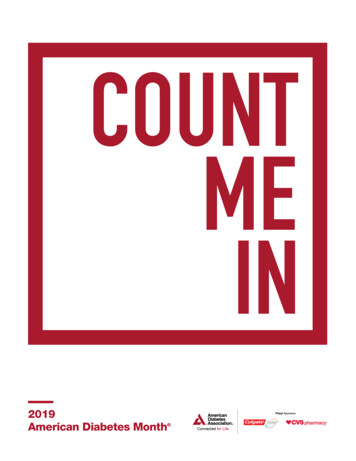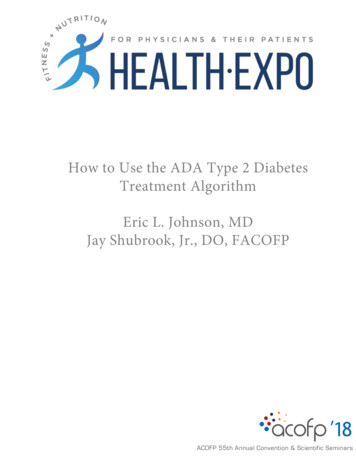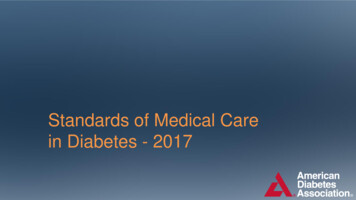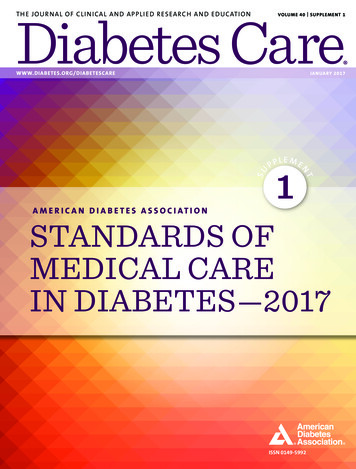
Transcription
TH E J O U R NAL O F C LI N ICA L A N D A PPLI ED R ESEA RC H A N D EDU CATI O NVOLUME 40 SUPPLEMENT 1WWW.DIABETES.ORG/DIABETESCARELEME1TA M E R I C A N D I A B E T E S A S S O C I AT I O NPPNSUJANUARY 2017STANDARDS OFMEDICAL CAREIN DIABETES—2017ISSN 0149-5992
American Diabetes AssociationStandards ofMedical Care inDiabetesd2017
January 2017 Volume 40, Supplement 1[T]he simple word Care may suffice to express [the journal’s] philosophicalmission. The new journal is designed to promote better patient care byserving the expanded needs of all health professionals committed to the careof patients with diabetes. As such, the American Diabetes Association viewsDiabetes Care as a reaffirmation of Francis Weld Peabody’s contention that“the secret of the care of the patient is in caring for the patient.”—Norbert Freinkel, Diabetes Care, January-February 1978EDITOR IN CHIEFWilliam T. Cefalu, MDASSOCIATE EDITORSEDITORIAL BOARDGeorge Bakris, MDLawrence Blonde, MD, FACPAndrew J.M. Boulton, MDDavid D’Alessio, MDMary de Groot, PhDEddie L. Greene, MDFrank B. Hu, MD, MPH, PhDSteven E. Kahn, MB, ChBDerek LeRoith, MD, PhDRobert G. Moses, MDStephen Rich, PhDMatthew C. Riddle, MDJulio Rosenstock, MDWilliam V. Tamborlane, MDKatie Weinger, EdD, RNJudith Wylie-Rosett, EdD, RDNicola Abate, MDVanita R. Aroda, MDGeremia Bolli, MDJohn B. Buse, MD, PhDRobert J. Chilton, DO, FACC, FAHAKenneth Cusi, MD, FACP, FACEParesh Dandona, MD, PhDJ. Hans DeVries, MD, PhDEle Ferrannini, MDFranco Folli, MD, PhDMeredith A. Hawkins, MD, MSRichard Hellman, MDNorbett Hermanns, PhD, MScGeorge S. Jeha, MDIrl B. Hirsch, MD, MACPLee M. Kaplan, MD, PhDM. Sue Kirkman, MDIldiko Lingvay, MD, MPH, MSCSHarold David McIntyre, MD, FRACPAMERICAN DIABETES ASSOCIATION OFFICERSCHAIR OF THE BOARDDavid A. DeMarco, PhDPRESIDENT, MEDICINE & SCIENCEAlvin C. Powers, MDPRESIDENT, HEALTH CARE & EDUCATIONBrenda Montgomery, RN, MSHS, CDESECRETARY/TREASURERUmesh VermaCHIEF EXECUTIVE OFFICERKevin L. HaganThe mission of the American Diabetes Associationis to prevent and cure diabetes and to improvethe lives of all people affected by diabetes.Maureen Monaghan, PhD, CDEKristen J. Nadeau, MD, MSKwame Osei, MDKevin A. Peterson, MD, MPH, FRCS(Ed),FAAFPJonathan Q. Purnell, MDPeter Reaven, MDRavi Retnakaran, MD, MSc, FRCPCHelena Wachslicht Rodbard, MDElizabeth Seaquist, MDGuntram Schernthaner, MDDavid J. Schneider, MDNorbert Stefan, MDJan S. Ulbrecht, MB, BSJoseph Wolfsdorf, MD, BChTien Yin Wong, MBBS, FRCSE, FRANZCO,MPH, PhDBernard Zinman, CM, MD, FRCPC, FACP
Diabetes Care is a journal for the health care practitioner that is intended toincrease knowledge, stimulate research, and promote better management of peoplewith diabetes. To achieve these goals, the journal publishes original research onhuman studies in the following categories: Clinical Care/Education/Nutrition/Psychosocial Research, Epidemiology/Health Services Research, EmergingTechnologies and Therapeutics, Pathophysiology/Complications, and Cardiovascularand Metabolic Risk. The journal also publishes ADA statements, consensus reports,clinically relevant review articles, letters to the editor, and health/medical news or pointsof view. Topics covered are of interest to clinically oriented physicians, researchers,epidemiologists, psychologists, diabetes educators, and other health professionals.More information about the journal can be found online at care.diabetesjournals.org.Copyright 2017 by the American Diabetes Association, Inc. All rights reserved. Printed inthe USA. Requests for permission to reuse content should be sent to Copyright ClearanceCenter at www.copyright.com or 222 Rosewood Dr., Danvers, MA 01923; phone: (978)750-8400; fax: (978) 646-8600. Requests for permission to translate should be sent toPermissions Editor, American Diabetes Association, at permissions@diabetes.org.The American Diabetes Association reserves the right to reject any advertisement forany reason, which need not be disclosed to the party submitting the advertisement.Commercial reprint orders should be directed to Sheridan Content Services,(800) 635-7181, ext. 8065.Single issues of Diabetes Care can be ordered by calling toll-free (800) 232-3472, 8:30 A.M.to 5:00 P.M. EST, Monday through Friday. Outside the United States, call (703) 549-1500.Rates: 75 in the United States, 95 in Canada and Mexico, and 125 for all other countries.PRINT ISSN 0149-5992ONLINE ISSN 1935-5548PRINTED IN THE USADiabetes Care is available online at care.diabetesjournals.org. Please call thenumbers listed above, e-mail membership@diabetes.org, or visit the online journal formore information about submitting manuscripts, publication charges, ordering reprints,subscribing to the journal, becoming an ADA member, advertising, permission to reusecontent, and the journal’s publication policies.Periodicals postage paid at Alexandria, VA, and additional mailing offices.AMERICAN DIABETES ASSOCIATION PERSONNEL AND CONTACTSVICE PRESIDENT, PUBLISHEREDITORIAL CONTENT MANAGERMichael EisensteinNancy C. BaldinoASSOCIATE PUBLISHER,SCHOLARLY JOURNALSTECHNICAL EDITORSChristian S. KohlerOedipa RiceTheresa CooperPHARMACEUTICAL/DEVICE DIGITAL ADVERTISINGEDITORIAL OFFICE DIRECTORLyn ReynoldsASSOCIATE DIRECTOR, BILLING & COLLECTIONSPEER REVIEW MANAGERLaurie Ann HallShannon PottsEDITORIAL ASSISTANTJoan GarrettDonald CrowlHeather Norton BlackburnCONTENT PRODUCTION MANAGERKelly Newtone-Healthcare SolutionsJohn BurkeChief Revenue Officersales@ehsmail.com(609) 882-8887, ext. 149PHARMACEUTICAL/DEVICE PRINT ADVERTISINGDIRECTOR, MEMBERSHIP/SUBSCRIPTIONSERVICESDIRECTOR, SCHOLARLY JOURNALSADVERTISING SALESSENIOR ADVERTISING MANAGERJulie DeVoss Graffjdevoss@diabetes.org(703) 299-5511The Jackson-Gaeta Group, Inc.B. Joseph Jacksonjoejackson@jacksongaeta.comPaul Nalbandianpaulnalbandian@jacksongaeta.comTina Aulettatinaauletta@jacksongaeta.com(973) 403-7677
January 2017 Volume 40, Supplement 1Standards of Medical Care in Diabetes—2017S1S3S4S6IntroductionProfessional Practice CommitteeStandards of Medical Care in Diabetes—2017:Summary of Revisions1. Promoting Health and Reducing Disparities inPopulationsDiabetes and Population HealthTailoring Treatment to Reduce DisparitiesS11S33S48S996. Glycemic TargetsS105S114S64S12014. Diabetes Care in the HospitalHospital Care Delivery StandardsGlycemic Targets in Hospitalized PatientsBedside Blood Glucose MonitoringAntihyperglycemic Agents in HospitalizedPatientsHypoglycemiaMedical Nutrition Therapy in the HospitalSelf-management in the HospitalStandards for Special SituationsTransition From the Acute Care SettingPreventing Admissions and ReadmissionsS1288. Pharmacologic Approaches to GlycemicTreatmentPharmacologic Therapy for Type 1 DiabetesPharmacologic Therapy for Type 2 Diabetes13. Management of Diabetes in PregnancyDiabetes in PregnancyPreconception CounselingGlycemic Targets in PregnancyManagement of Gestational Diabetes MellitusManagement of Preexisting Type 1 Diabetesand Type 2 Diabetes in PregnancyPostpartum CarePregnancy and Drug Considerations7. Obesity Management for the Treatment of Type 2DiabetesAssessmentDiet, Physical Activity, and Behavioral TherapyPharmacotherapyMetabolic Surgery12. Children and AdolescentsType 1 DiabetesType 2 DiabetesTransition From Pediatric to Adult CareAssessment of Glycemic ControlA1C TestingA1C GoalsHypoglycemiaIntercurrent IllnessS5711. Older AdultsNeurocognitive FunctionHypoglycemiaTreatment GoalsPharmacologic TherapyTreatment in Skilled Nursing Facilitiesand Nursing HomesEnd-of-Life Care5. Prevention or Delay of Type 2 DiabetesLifestyle InterventionsPharmacologic InterventionsPrevention of Cardiovascular DiseaseDiabetes Self-management Education and Support10. Microvascular Complications andFoot CareDiabetic Kidney DiseaseDiabetic RetinopathyNeuropathyFoot Care4. Lifestyle ManagementDiabetes Self-management Education and SupportNutrition TherapyPhysical ActivitySmoking Cessation: Tobacco and e-CigarettesPsychosocial IssuesS44S883. Comprehensive Medical Evaluation andAssessment of ComorbiditiesPatient-Centered Collaborative CareComprehensive Medical EvaluationAssessment of Comorbidities9. Cardiovascular Disease and RiskManagementHypertension/Blood Pressure ControlLipid ManagementAntiplatelet AgentsCoronary Heart Disease2. Classification and Diagnosis of DiabetesClassificationDiagnostic Tests for DiabetesCategories of Increased Risk for Diabetes (Prediabetes)Type 1 DiabetesType 2 DiabetesGestational Diabetes MellitusMonogenic Diabetes SyndromesCystic Fibrosis–Related DiabetesPosttransplantation Diabetes MellitusS25S7515. Diabetes AdvocacyAdvocacy Position StatementsS130Professional Practice Committee DisclosuresS132IndexThis issue is freely accessible online at care.diabetesjournals.org.Keep up with the latest information for Diabetes Care and other ADA titles via Facebook (/ADAJournals) and Twitter (@ADA Journals).
Diabetes Care Volume 40, Supplement 1, January 2017S1INTRODUCTIONIntroductionDiabetes Care 2017;40(Suppl. 1):S1–S2 DOI: 10.2337/dc17-S001Diabetes is a complex, chronic illness requiring continuous medical care withmultifactorial risk-reduction strategiesbeyond glycemic control. Ongoing patientself-management education and supportare critical to preventing acute complications and reducing the risk of long-termcomplications. Significant evidence existsthat supports a range of interventions toimprove diabetes outcomes.The American Diabetes Association’s(ADA’s) “Standards of Medical Care in Diabetes,” referred to as the “Standards ofCare,” is intended to provide clinicians, patients, researchers, payers, and other interested individuals with the componentsof diabetes care, general treatment goals,and tools to evaluate the quality of care.The Standards of Care recommendationsare not intended to preclude clinical judgment and must be applied in the contextof excellent clinical care, with adjustmentsfor individual preferences, comorbidities,and other patient factors. For more detailed information about management ofdiabetes, please refer to Medical Management of Type 1 Diabetes (1) and MedicalManagement of Type 2 Diabetes (2).The recommendations include screening, diagnostic, and therapeutic actionsthat are known or believed to favorablyaffect health outcomes of patients with diabetes. Many of these interventions havealso been shown to be cost-effective (3).The ADA strives to improve and update the Standards of Care to ensurethat clinicians, health plans, and policymakers can continue to rely on them asthe most authoritative and currentguidelines for diabetes care.ADA STANDARDS, STATEMENTS,AND REPORTSThe ADA has been actively involved inthe development and dissemination ofdiabetes care standards, guidelines, andrelated documents for over 25 years.ADA’s clinical practice recommendationsare viewed as important resources forhealth care professionals who care forpeople with diabetes. ADA’s Standardsof Care, position statements, and scientific statements undergo a formal reviewprocess by ADA’s Professional Practice Committee (PPC) and the Board ofDirectors. Readers who wish to commenton the 2017 Standards of Care are invitedto do so at http://professional.diabetes.org/SOC.Standards of CareStandards of Care: ADA position statement that provides key clinical practicerecommendations. The PPC performs anextensive literature search and updatesthe Standards of Care annually basedon the quality of new evidence.ADA Position StatementA position statement is an official ADApoint of view or belief that contains clinical or research recommendations. Position statements are issued on scientificor medical issues related to diabetes.They are published in the ADA journalsand other scientific/medical publications. ADA position statements are typically based on a systematic review orother review of published literature.Position statements undergo a formalreview process. They are updated every5 years or as needed.ADA Scientific StatementA scientific statement is an official ADApoint of view or belief that may or maynot contain clinical or research recommendations. Scientific statements contain scholarly synopsis of a topic relatedto diabetes. Workgroup reports fall intothis category. Scientific statements arepublished in the ADA journals and otherscientific/medical publications, as appropriate. Scientific statements alsoundergo a formal review process.Consensus ReportA consensus report contains a comprehensive examination by an expert panel(i.e., consensus panel) of a scientific ormedical issue related to diabetes. A consensus report is not an ADA position andrepresents expert opinion only. The category may also include task force andexpert committee reports. The needfor a consensus report arises when clinicians or scientists desire guidance on asubject for which the evidence is contradictory or incomplete. A consensus report is developed following a consensusconference where the controversial issueis extensively discussed. The reportrepresents the panel’s collective analysis, evaluation, and opinion at thatpoint in time based in part on the conference proceedings. A consensus report does not undergo a formal ADAreview process.GRADING OF SCIENTIFIC EVIDENCESince the ADA first began publishingpractice guidelines, there has been considerable evolution in the evaluation ofscientific evidence and in the development of evidence-based guidelines. In2002, the ADA developed a classificationsystem to grade the quality of scientificevidence supporting ADA recommendations for all new and revised ADA position statements. A recent analysis of theevidence cited in the Standards of Carefound steady improvement in qualityover the past 10 years, with the 2014Standards of Care for the first timehaving the majority of bulleted recommendations supported by A- or B-levelevidence (4). A grading system (Table1) developed by the ADA and modeledafter existing methods was used to clarify and codify the evidence that formsthe basis for the recommendations. ADArecommendations are assigned ratingsof A, B, or C, depending on the quality“Standards of Medical Care in Diabetes” was originally approved in 1988. Most recent review/revision: December 2015. 2017 by the American Diabetes Association. Readers may use this article as long as the work is properly cited, the use is educational and not for profit,and the work is not altered. More information is available at http://www.diabetesjournals.org/content/license.
S2IntroductionDiabetes Care Volume 40, Supplement 1, January 2017Table 1—ADA evidence-grading system for “Standards of Medical Care in Diabetes”Level ofevidenceDescriptionAClear evidence from well-conducted, generalizable randomized controlled trialsthat are adequately powered, includingc Evidence from a well-conducted multicenter trialc Evidence from a meta-analysis that incorporated quality ratings in theanalysisCompelling nonexperimental evidence, i.e., “all or none” rule developed by theCentre for Evidence-Based Medicine at the University of OxfordSupportive evidence from well-conducted randomized controlled trials that areadequately powered, includingc Evidence from a well-conducted trial at one or more institutionsc Evidence from a meta-analysis that incorporated quality ratings in theanalysisBSupportive evidence from well-conducted cohort studiesc Evidence from a well-conducted prospective cohort study or registryc Evidence from a well-conducted meta-analysis of cohort studiesSupportive evidence from a well-conducted case-control studyCSupportive evidence from poorly controlled or uncontrolled studiesc Evidence from randomized clinical trials with one or more major or three ormore minor methodological flaws that could invalidate the resultsc Evidence from observational studies with high potential for bias (such ascase series with comparison with historical controls)c Evidence from case series or case reportsConflicting evidence with the weight of evidence supporting therecommendationEExpert consensus or clinical experienceof evidence. Expert opinion E is a separate category for recommendations inwhich there is no evidence from clinicaltrials, in which clinical trials may be impractical, or in which there is conflictingevidence. Recommendations with an Arating are based on large well-designedclinical trials or well-done meta-analyses.Generally, these recommendationshave the best chance of improving outcomes when applied to the populationto which they are appropriate. Recommendations with lower levels of evidence may be equally important butare not as well supported. Of course,evidence is only one component ofclinical decision making. Clinicians carefor patients, not populations; guidelinesmust always be interpreted with theindividual patient in mind. Individualcircumstances, such as comorbid andcoexisting diseases, age, education, disability, and, above all, patients’ valuesand preferences, must be consideredand may lead to different treatment targets and strategies. Furthermore, conventional evidence hierarchies, such asthe one adapted by the ADA, may missnuances important in diabetes care. Forexample, although there is excellent evidence from clinical trials supportingthe importance of achieving multiplerisk factor control, the optimal way toachieve this result is less clear. It is difficult to assess each component ofsuch a complex intervention.References1. American Diabetes Association. MedicalManagement of Type 1 Diabetes. 6th ed.Kaufman FR, Ed. Alexandria, VA, American Diabetes Association, 20122. American Diabetes Association. MedicalManagement of Type 2 Diabetes. 7th ed.Burant CF, Young LA, Eds. Alexandria, VA, American Diabetes Association, 20123. Li R, Zhang P, Barker LE, Chowdhury FM,Zhang X. Cost-effectiveness of interventions toprevent and control diabetes mellitus: a systematic review. Diabetes Care 2010;33:1872–18944. Grant RW, Kirkman MS. Trends in the evidence level for the American Diabetes Association’s “Standards of Medical Care in Diabetes”from 2005 to 2014. Diabetes Care 2015;38:6–8
S3Professional Practice CommitteeDiabetes Care 2017;40(Suppl. 1):S3 DOI: 10.2337/dc17-S002The Professional Practice Committee(PPC) of the American Diabetes Association (ADA) is responsible for the“Standards of Medical Care in Diabetes”position statement, referred to as the“Standards of Care.” The PPC is a multidisciplinary expert committee comprised of physicians, diabetes educators,registered dietitians, and others whohave expertise in a range of areas, including adult and pediatric endocrinology, epidemiology, public health, lipidresearch, hypertension, preconceptionplanning, and pregnancy care. Appointment to the PPC is based on excellencein clinical practice and research. Althoughthe primary role of the PPC is to reviewand update the Standards of Care, it isalso responsible for overseeing the reviewand revision of ADA’s position statementsand scientific statements.The ADA adheres to the Institute ofMedicine Standards for Developing Trustworthy Clinical Practice Guidelines. Allmembers of the PPC are required to disclose potential conflicts of interest withindustry and/or other relevant organizations. These disclosures are discussedat the onset of each Standards of Care revision meeting. Members of the committee, their employer, and their disclosedconflicts of interest are listed in the“Professional Practice Committee Disclosures” table (see p. S130).For the current revision, PPC memberssystematically searched MEDLINE forhuman studies related to each sectionand published since 1 January 2016. Recommendations were revised based onnew evidence or, in some cases, to clarify the prior recommendation or matchthe strength of the wording to the strengthof the evidence. A table linking the changesin recommendations to new evidencecan be reviewed at http://professional.diabetes.org/SOC. As for all positionstatements, the Standards of Care position statement was approved by theExecutive Committee of ADA’s Boardof Directors, which includes healthcare professionals, scientists, and laypeople.Feedback from the larger clinicalcommunity was valuable for the 2017 revision of the Standards of Care. Readerswho wish to comment on the 2017Standards of Care are invited to do so athttp://professional.diabetes.org/SOC.The ADA funds development of theStandards of Care and all ADA positionstatements out of its general revenuesand does not use industry support forthese purposes. The PPC would liketo thank the following individualswho provided their expertise in reviewing and/or consulting with thecommittee: Conor J. Best, MD; WilliamT. Cefalu, MD; Mary de Groot, PhD;Gary D. Hack, DDS; Silvio E. Inzucchi,MD; Meghan Jardine, MS, MBA, RD,LD, CDE; Victor R. Lavis, MD; Mark E.Molitch, MD; Antoinette Moran, MD;Matt Petersen; Sean Petrie; Louis H.Philipson, MD, PhD; Margaret A.Powers, PhD, RD, CDE; DesmondSchatz, MD; Philip R. Schauer, MD;Sonali N. Thosani, MD; and GuillermoE. Umpierrez, MD.Members of the PPCWilliam H. Herman, MD, MPH (Co-Chair)Rita R. Kalyani, MD, MHS, FACP (Co-Chair)*Andrea L. Cherrington, MD, MPHDonald R. Coustan, MDIan de Boer, MD, MSRobert James Dudl, MDHope Feldman, CRNP, FNP-BCHermes J. Florez, MD, PhD, MPH*Suneil Koliwad, MD, PhD*Melinda Maryniuk, MEd, RD, CDEJoshua J. Neumiller, PharmD, CDE, FASCP*Joseph Wolfsdorf, MB, BCh*Subgroup leadersADA StaffErika Gebel Berg, PhD(Corresponding author:eberg@diabetes.org)Sheri Colberg-Ochs, PhDAlicia H. McAuliffe-Fogarty, PhD, CPsycholSacha Uelmen, RDN, CDERobert E. Ratner, MD, FACP, FACE 2017 by the American Diabetes Association. Readers may use this article as long as the work is properly cited, the use is educational and not for profit,and the work is not altered. More information is available at OFESSIONAL PRACTICE COMMITTEEDiabetes Care Volume 40, Supplement 1, January 2017
SUMMARY OF REVISIONSS4Diabetes Care Volume 40, Supplement 1, January 2017Standards of Medical Care in Diabetesd2017:Summary of RevisionsDiabetes Care 2017;40(Suppl. 1):S4–S5 DOI: 10.2337/dc17-S003GENERAL CHANGESIn light of the American Diabetes Association’s (ADA’s) new position statement onpsychosocial care in the treatment of diabetes, the “Standards of Medical Care inDiabetes,” referred to as the “Standards ofCare,” has been updated to address psychosocial issues in all aspects of care including self-management, mental health,communication, complications, comorbidities, and life-stage considerations.Although levels of evidence for severalrecommendations have been updated,these changes are not addressed belowas the clinical recommendations have remained the same. Changes in evidencelevel from, for example, E to C are notnoted below. The 2017 Standards ofCare contains, in addition to many minorchanges that clarify recommendations orreflect new evidence, the following moresubstantive revisions.SECTION CHANGESSection 1. Promoting Health andReducing Disparities in PopulationsThis section was renamed and now focuses on improving outcomes and reducing disparities in populations withdiabetes.Recommendations were added to assess patients’ social context as well asrefer to local community resources andprovide self-management support.Section 2. Classification and Diagnosisof DiabetesThe section was updated to include anew consensus on the staging of type 1diabetes (Table 2.1) and a discussion of aproposed unifying diabetes classificationscheme that focuses on b-cell dysfunction and disease stage as indicated byglucose status.Language was added to clarify screening and testing for diabetes. Screeningapproaches were described, and Fig. 2.1was included to provide an example of avalidated tool to screen for prediabetes andpreviously undiagnosed type 2 diabetes.Due to recent data, delivering a babyweighing 9 lb or more is no longer listedas an independent risk factor for thedevelopment of prediabetes and type 2diabetes.A section was added that discussesrecent evidence on screening for diabetes in dental practices.The recommendation to test womenwith gestational diabetes mellitus forpersistent diabetes was changed from6–12 weeks’ postpartum to 4–12 weeks’postpartum to allow the test to be scheduled just before the standard 6-week postpartum obstetrical checkup so that theresults can be discussed with the patientat that time of the visit or to allow the testto be rescheduled at the visit if the patientdid not get the test.Additional detail was added to thesection on monogenic diabetes syndromes, and a new table was added (Table 2.7) describing the most commonforms of monogenic diabetes.A new section was added on posttransplantation diabetes mellitus.Section 3. Comprehensive MedicalEvaluation and Assessment ofComorbiditiesThis new section, including componentsof the 2016 section “Foundations ofCare and Comprehensive Medical Evaluation,” highlights the importance ofassessing comorbidities in the contextof a patient-centered comprehensivemedical evaluation.A new discussion of the goals of providerpatient communication is included.The Standards of Care now recommends the assessment of sleep patternand duration as part of the comprehensivemedical evaluation based on emerging evidence suggesting a relationship betweensleep quality and glycemic control.An expanded list of diabetes comorbidities now includes autoimmune diseases,HIV, anxiety disorders, depression, disordered eating behavior, and serious mentalillness.Section 4. Lifestyle ManagementThis section, previously entitled “Foundations of Care and ComprehensiveMedical Evaluation,” was refocused onlifestyle management.The recommendation for nutritiontherapy in people prescribed flexible insulin therapy was updated to include fatand protein counting in addition to carbohydrate counting for some patients toreflect evidence that these dietary factors influence insulin dosing and bloodglucose levels.Based on new evidence of glycemicbenefits, the Standards of Care nowrecommends that prolonged sitting beinterrupted every 30 min with shortbouts of physical activity.A recommendation was added tohighlight the importance of balanceand flexibility training in older adults.A new section and table provide information on situations that might warrantreferral to a mental health provider.Section 5. Prevention or Delay ofType 2 DiabetesTo help providers identify those patientswho would benefit from prevention efforts, new text was added emphasizingthe importance of screening for prediabetes using an assessment tool or informalassessment of risk factors and performinga diagnostic test when appropriate.To reflect new evidence showing anassociation between B12 deficiency andlong-term metformin use, a recommendation was added to consider periodic 2017 by the American Diabetes Association. Readers may use this article as long as the work is properly cited, the use is educational and not for profit,and the work is not altered. More information is available at http://www.diabetesjournals.org/content/license.
care.diabetesjournals.orgmeasurement of B12 levels and supplementation as needed.Section 6. Glycemic TargetsBased on recommendations from the International Hypoglycaemia Study Group,serious, clinically significant hypoglycemiais now defined as glucose ,54 mg/dL(3.0 mmol/L), while the glucose alert valueis defined as #70 mg/dL (3.9 mmol/L) (Table 6.3). Clinical implications are discussed.Section 7. Obesity Management forthe Treatment of Type 2 DiabetesTo be consistent with other ADA positionstatements and to reinforce the role ofsurgery in the treatment of type 2 diabetes, bariatric surgery is now referred to asmetabolic surgery.To reflect the results of an internationalworkgroup report endorsed by the ADAand many other organizations, recommendations regarding metabolic surgeryhave been substantially changed, including those related to BMI thresholdsfor surgical candidacy (Table 7.1), mental health assessment, and appropriatesurgical venues.Section 8. Pharmacologic Approachesto Glycemic TreatmentThe title of this section was changed from“Approaches to Glycemic Treatment” to“Pharmacologic Approaches to GlycemicTreatment” to reinforce that the sectionfocuses on pharmacologic therapy alone.Lifestyle management and obesity management are discussed in separate chapters.To reflect new evidence showing an association between B12 deficiency and longterm metformin use, a recommendationwas added to consider periodic measurement of B12 levels and supplementationas needed.A section was added describing therole of newly available biosimilar insulins in diabetes care.Based on the results of two large clinical trials, a recommendation was addedto consider empagliflozin or liraglutide inpatients with established cardiovasculardisease to reduce the risk of mortality.Figure 8.1, antihyperglycemic therapy in type 2 diabetes, was updated toacknowledge the high cost of insulin.Summary of RevisionsThe algorithm for the use of combination injectable therapy in patients withtype 2 diabetes (Fig. 8.2) has been changedto reflect studies demonstrating the noninferiority of basal insulin plus glucagonlike peptide 1 receptor agonist versus basalinsulin plus rapid-acting insulin versus twodaily injections of premixed insulin, as wellas studies demonstrating the noninferiority of multiple dose premixed insulin regimens versus basal-bolus therapy.Due to concerns about the affordabilityof antihyperglycemic agents, new tableswere added showing the median costs ofnoninsulin agents (Table 8.2) and insulins(Table 8.3).Section 9. Cardiovascular Disease andRisk ManagementTo better align with existing data, the hypertension treatment recommendationfor diabetes now suggests that, for patients without albuminuria, any of thefour classes of blood pressure medications(ACE inhibitors, angiotensin receptorblockers, thiazide-like diuretics, or dihydropyridine calcium channel blockers)that have shown beneficial cardiovascularoutcomes may be used.To optimize maternal health withoutrisking fetal harm, the recommendationfor the treatment of pregnant pa
Jan 01, 2016 · Permissions Editor, American Diabetes Association, at permissions@diabetes.org. The American Diabetes Association reserves the right to reject any advertisement for any reason, which need not be disclosed to the party submitting the advertisement. Commercial reprint orders should be directed to Sheridan Content Services, (800) 635-7181, ext. 8065.File Size: 2MB
